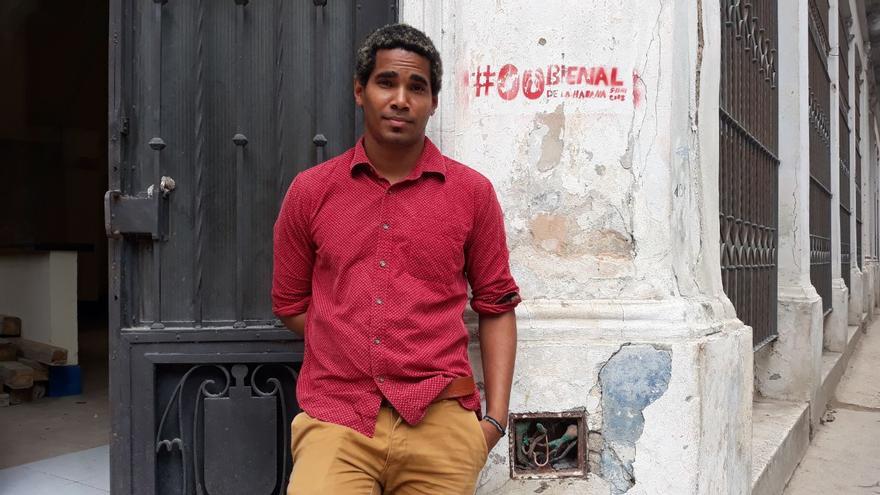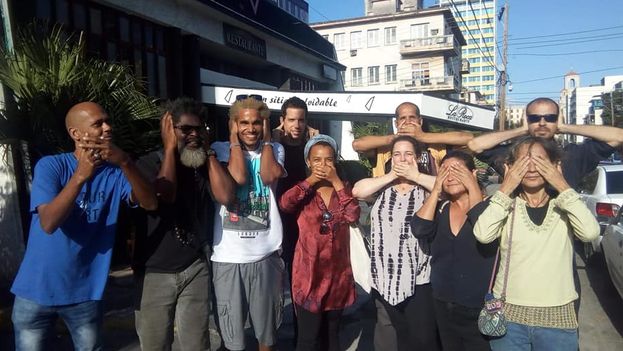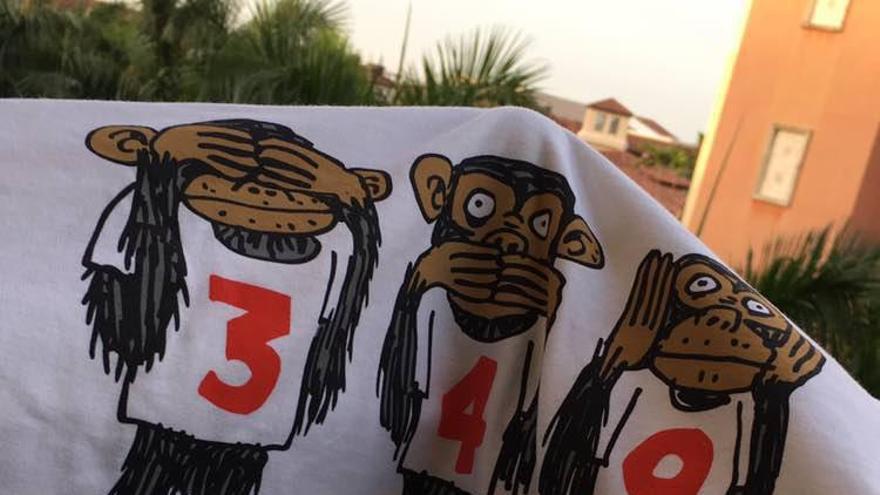“First we were in the eleventh unit of the San Miguel de Padrón police station, there we spent Monday night and on Tuesday they took us to Vivac (the State Security detention center), and when we arrived they did not want to accept us because Luis was on-strike and they returned us to the unit but in the night they accepted us (at Vivac) and we stayed there until they let us go. During the interrogations they told us that if we protested again in front of the Ministry of Culture they would accuse us of illegal association and demonstrating without permission.”
Núñez explained that Luis Manuel Otero, after leaving prison after more than 48 hours on hunger and thirst strike, had taken a soda. continue reading
On the other hand, on the night of Tuesday, the artists Amaury Pacheco and the producer Michel Matos were released, according to Pacheco himself, speaking to14ymedio after being released
Both were detained in the midst of a repressive wave by State Security against a peaceful sit-in in front of the Ministry of Culture (Mincuult) headquarters as a part of the campaign against Decree 349. Pacheco explained that his hunger strike will be maintained “as long as any artist is in prison” and he will return this morning to the Ministry of Culture if Yanelys Núñez and Luis Manuel Otero are not released during the night.
Pacheco said that when he arrived at the Ministry of Culture on November 3, both he and Matos were detained and that they spent most of their time in the police unit of the municipality of Regla. “Michel was taken first to Guanabacoa but then they brought him to the same jail where I was in Regla, there they interrogated us and told me that if I went back to Mincult I would be imprisoned for one to three years,” he said.
This newspaper was also able to speak with artist Tania Bruguera after she was released on Tuesday night after her third arrest, including her first arrest at the beginning of the protest. “They held me from nine in the morning until nine at night but they did not take me to a unit, they left me inside the car until three thirty in the afternoon at La Puntilla and then they took me to a house that is beyond Lenin Park, by way of Calvario,” explained the artist.
She says that at every moment the agents told her they would take her home but when she expressed her desire to return to the Ministry of Culture, that proposal was postponed until finally at nine o’clock in the evening they left her at the door of her house. During the detention in the house where the artist was taken, they offered her water and food, even though she had told her captors that she was on a hunger and thirst strike.
“They took me to a room with a table covered with food, I told them I was not going to eat, then they gave me a cold water bottle but I told him to keep it and later they also offered me ice cream but I also refused,” says the renowned artist.
“You know how I react when someone is imprisoned because it happened in 2014, I will talk with no problems when no one is being held prisoner,” Bruguera told the agent.
The musician Sandor Pérez Pita, from the reggae group Estudiantes sin Semilla (Students without Seed), was also released in the afternoon.
The artist Amaury Pacheco had affirmed that he maintained his hunger and thirst strike until they released the rest of the artists and that “the fight against Decree 349 continues.” In a video posted on his social networks he said this entire battle is being fought “for art, for freedom of expression.”
In conversation with 14ymedio, Tania Bruguera said that the intention was to return on Thursday to the Ministry of Culture to demand again the release of Yanelys Núñez Leyva and Luis Manuel Otero Alcántara to establish a dialogue with the institution and to ask for a response.
Artists from several countries have mobilized since Tuesday in favor of the release of the group of artists who oppose Decree 349. The director of the Tate Modern gallery in London, Frances Morris, expressed on Twitter that these arrests clearly illustrate the threats many artists around the world are facing.
Also this Wednesday afternoon a public session was held in the Turbine Hall to say “No to Decree 349” and provide support to detainees through an open microphone to those who wish to participate.
The Bureau of Human Rights, Democracy and Labor of the US State Department wrote on its Twitter account that “the Government of Cuba continues to criminalize freedom of expression while besieging artists and journalists to discourage protests against Decree 349.”
Meanwhile, Silvio Rodríguez wrote a comment on the blog Segunda Cita that “Decree 349 may have very good intentions but I’m sure it would be better if it were discussed with the artists.” He added that “it was something cooked up among the few” and that in his opinion “a disposition of this scopes must have a more democratic origin, and a purpose.”
“Perhaps there should be a moratorium on the decree, until an acceptable modification is discussed and resolved, and I do not know whether I will be able to work abroad as I have been doing, starting next year. I began to work on my own in the face of the very inefficient state contracting and coordination mechanisms,” the troubadour wrote.
Deborah Bruguera, Tania’s sister, wrote: “While on the phone with Tania Bruguera, Lt. Col. Kenia took her in a car, right at the corner of the MINCULT.” The artist sent a public statement “of the artists who have called for the sit-in at the Ministry of Culture of Cuba,” that her sister shared on social networks.
We reproduce the text in its entirety:
We have decided to make a call to sit peacefully and respectfully to camp, meditate, read poetry, dance, paint or perform any artistic activity in front of the Ministry of Culture because:
1: The artists of all the demonstrations, have carried them out in an organized way and through institutional channels to request the repeal of Decree 349 and its subsequent drafting with the assistance of the artists.
2: Even though these groups have met with leaders of the Ministry of Culture, the promises that they have made to respond have not been met and, failing that, a technical article was published in the Granma newspaper on November 30, justifying the validity of the current Decree 349, along with a bombardment on national television of programs with explanations in favor of 349 in its current format. This seems indicative to us that Decree 349 will not be repealed because this seems to be an action with the purpose of setting the population against our demands.
3: [The government] has commented that regulations and corrective rules will be made for the implementation of Decree 349. This seems insufficient because, given that the Decree has serious errors of representation and puts artists in a state of vulnerability, by criminalizing them and their works, we do not believe that it is appropriate to proceed with how to implement the Decree, if not the Decree itself.
4: December 7th is approaching, the date on which Decree Law 349 will become effective. We are asking for a meeting open to all with the Minister of Culture to inform us what has been the result of the meetings held with the artists and what will happen with Decree 349.
We want to receive from the Ministry of Culture the same respect towards us that we have had towards them. We will continue presenting ourselves to the Ministry of Culture to ask for our right to a response and open meeting with all the artists.
____________________
The 14ymedio team is committed to serious journalism that reflects the reality of deep Cuba. Thank you for joining us on this long road. We invite you to continue supporting us, but this time by becoming a member of 14ymedio. Together we can continue to transform journalism in Cuba.

![]() 14ymedio, Havana, 4 June 2019 — The police released artist Luis Manuel Otero Alcántara on Tuesday afternoon after he spent 24 hours in the San Miguel del Padrón police station, the independent artist explained to 14ymedio.
14ymedio, Havana, 4 June 2019 — The police released artist Luis Manuel Otero Alcántara on Tuesday afternoon after he spent 24 hours in the San Miguel del Padrón police station, the independent artist explained to 14ymedio.



